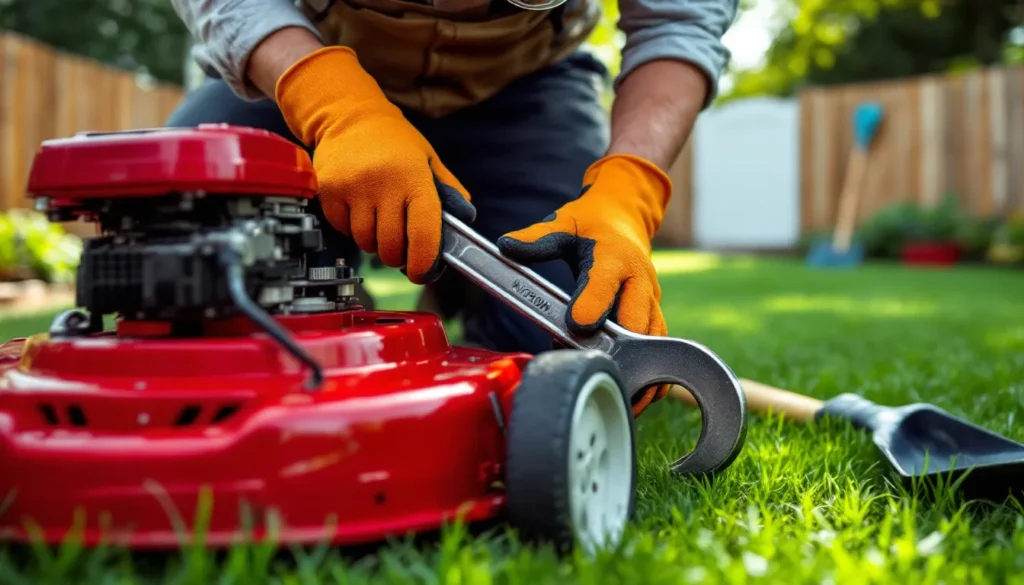Maintaining your lawn mower is crucial for a healthy lawn, and one of the most important tasks is removing the blade for sharpening or replacement. If you want to keep your mower running smoothly, knowing how to safely and efficiently remove the blade is essential.
In this guide, you’ll discover step-by-step instructions that make the process simple and straightforward. Whether you’re a seasoned DIYer or a first-time mower owner, you’ll find the tips and tricks you need to tackle this task with confidence. Get ready to give your mower the care it deserves and ensure your lawn stays pristine all season long.
Tools Needed for Removing Lawn Mower Blade
Gather the necessary tools and safety gear before you start the process of removing your lawn mower blade. This preparation ensures safety and efficiency throughout the task.
Safety Gear
- Gloves: Wear heavy-duty work gloves to protect your hands from sharp edges and cuts.
- Protective Eyewear: Use safety glasses to safeguard your eyes from debris that could fly during the blade removal process.
- Sturdy Shoes: Opt for closed-toe, slip-resistant shoes to prevent foot injuries while working on the mower.
Essential Tools
- Wrench: A socket wrench or adjustable wrench helps loosen and tighten the blade bolts.
- Block of Wood: Use a sturdy block to secure the mower blade and prevent it from rotating during removal.
- Lifting Device: A jack or mower lift facilitates safe access to the mower’s underside.
- Oil Drain Pan: An oil drain pan catches any residual oil that may spill when tilting the mower.
- Wire Brush: A wire brush cleans rust or debris from the blade and bolts for easier handling.
Step-by-Step Guide on How to Remove Lawn Mower Blade

Follow these steps to safely remove the lawn mower blade. Proper preparation and execution ensure a smooth process.
Preparing the Mower
- Disconnect the spark plug wire to prevent accidental starting.
- Elevate the mower using a lifting device or ramp to gain clear access to the underside.
- Clear debris from the mower deck and surrounding area to maintain a clean workspace.
- Gather necessary tools, including a wrench, block of wood, oil drain pan, and wire brush for efficient operation.
Removing the Blade
- Secure the blade with a block of wood to prevent movement while loosening.
- Use the wrench to loosen and remove the bolts holding the blade in place.
- Lift the blade gently once the bolts are removed, taking care not to damage the mower’s spindle.
- Inspect the area for any remaining debris or rust using the wire brush as needed.
Cleaning the Blade Area
- Wipe down the blade area with a clean cloth to remove dirt and grass clippings.
- Inspect the blade mounting point for any signs of wear or damage; clean it thoroughly.
- Dispose of any oil or debris collected in the oil drain pan responsibly.
- Ensure the area is dry and free of obstructions before proceeding with reinstallation or sharpening.
Tips for Safe and Efficient Blade Removal
Ensure safety and efficiency by following these critical tips during blade removal. Proper precautions and awareness can prevent accidents and ensure the job gets done effectively.
Safety Precautions
- Disconnect the spark plug: Always unplug the spark plug wire before starting to prevent accidental engine starts.
- Use sturdy lifting equipment: Raise the mower securely using a jack or ramps to ensure stable access underneath the mower.
- Wear protective gear: Equip yourself with heavy-duty gloves, safety goggles, and steel-toed shoes to safeguard against injuries.
- Clear the workspace: Remove any debris or obstacles from the area to minimize trip hazards while working on the mower.
- Stabilize the mower: Ensure the mower is on a level surface and secured to prevent it from moving unexpectedly during blade removal.
Common Mistakes to Avoid
- Neglecting safety gear: Skipping protective equipment increases the risk of injury. Always wear gloves and goggles.
- Failing to disconnect the spark plug: Forgetting this crucial step can lead to unintended starts, creating a dangerous situation.
- Improper blade handling: Lifting or twisting the blade incorrectly can cause strains or cuts. Always secure it with a block of wood.
- Ignoring maintenance checks: Overlooking inspections for wear, rust, or debris accumulation can lead to further damage or accidents.
- Disposing of oil and debris improperly: Always collect and dispose of any spills or debris responsibly to maintain a safe working environment.
Maintenance After Blade Removal
Maintenance after blade removal is essential for optimal mower performance. Taking the time to sharpen and properly reattach the blade enhances cutting efficiency and extends the life of your mower.
Sharpening the Blade
Sharpening the blade ensures clean cuts, promoting healthy grass growth. Use a sharpening tool or bench grinder to hone the blade edges. Follow these steps:
- Secure the blade in a vice or clamp to maintain stability.
- Identify the cutting angle if it’s not uniform. Aim for a 30-degree angle for best results.
- File or grind the edges evenly, removing any nicks or damage. Avoid overheating, which can harm the metal.
- Inspect for balance; a balanced blade reduces vibrations and increases mower lifespan. Use a blade balancer to check.
Reattaching the Blade
Reattaching the blade correctly ensures safe operation and effective mowing. Follow these steps for secure installation:
- Align the blade on the mounting point, ensuring the sharp edges face the correct direction—typically up for proper cutting.
- Insert the bolts and hand-tighten to secure the blade before using a wrench.
- Tighten the bolts in a crisscross pattern to evenly distribute pressure and ensure a snug fit.
- Reconnect the spark plug wire once the blade installation is complete to restore mower functionality.
Perform these maintenance tasks diligently to safeguard your mower and maintain your lawn’s health.
Conclusion
Taking the time to remove and maintain your lawn mower blade is essential for keeping your mower in top shape. With the right tools and safety precautions you can confidently tackle this task. Regular blade removal and sharpening not only enhances your mower’s performance but also promotes a healthier lawn.
By following the steps outlined in this guide you’ll ensure a smooth process while avoiding common pitfalls. Remember that proper reattachment and maintenance are just as crucial. Stay proactive with your mower care and enjoy a lush green lawn all season long.

Hi, I’m Md Rofiqul, a gardening enthusiast who loves spending time in the garden and backyard. I enjoy caring for plants, growing flowers and vegetables, and creating a green space that feels peaceful and refreshing. Gardening is more than just a hobby, it’s a passion that connects me to nature and brings joy to my daily life. Living with plants inspires me to embrace simplicity, patience, and sustainability while making every day more colorful and rewarding.
